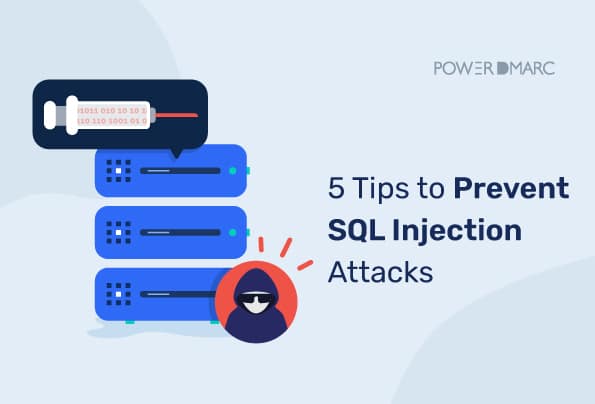Have you ever heard of the term SQL injection? Have you ever wondered how to prevent it? These are questions that many web developers ask themselves. Anyone can be vulnerable to this attack. But you don’t have to be one of them. Proper precautions allow you to defend your database from unauthorized access easily. It’s important to keep your website consumers safe from attacks such as SQL Injection so they can make purchases seamlessly.
Let’s go over to see what are SQL injection attacks and 5 tips for sql injection prevention.
Key Takeaways
- SQL injection is a prevalent attack method that targets data-driven applications by inserting malicious SQL statements.
- A zero-trust approach assumes all users are untrusted, urging strict access controls to mitigate SQL injection risks.
- Assigning minimal necessary privileges to user accounts reduces the potential impact of an attack.
- Using stored procedures can help safeguard databases by preventing direct user access through input fields.
- Implementing parameterized queries is essential for protecting against SQL injection by sanitizing user-provided input.
What are SQL Injection Attacks?
SQL injection is a code injection attack used to attack data-driven applications in which malicious SQL statements are inserted into an entry field for execution.
SQL injection attacks are the most common type of database security breach. SQL (Structured Query Language) is a programming language for accessing and manipulating databases. A web application uses an SQL database to store, retrieve and manipulate data.
These attacks may occurs when malicious users send commands to a database by entering them into input boxes on websites or web applications. The purpose of the attack is to modify or destroy the information stored in the database, either for malicious reasons or simply for the joy of watching things burn. The attacker’s goal is to make the database behave unintendedly so that information can be retrieved from it that wasn’t intended by its creators.
Whether you choose MariaDB or MySQL, no database is completely immune to the myriad tactics of modern hackers. As such you need to be proactive in preventing them from succeeding. Innovative web developers are essential for creating robust digital defenses against various cybersecurity threats.
Prevent SQL Injection Attacks with PowerDMARC!
Top Tips for Preventing SQL Injection Attacks
SQL injection attacks can be prevented by implementing the following best practices:
Zero Trust Approach
A zero-trust approach is an approach to security in which an organization assumes that all users, including administrators, external partners, and suppliers, are untrusted and potential attackers. The organization needs to apply strict controls on information access and use.
This includes eliminating or reducing dependencies on external connections to databases, applications, or services.
Stored procedures are one way to minimize the risk of SQL injection attacks since they are more secure than dynamic SQL queries. However, if stored procedures are used as well as dynamic queries, then care must be taken during testing to ensure that no vulnerabilities exist in the stored procedures.
Limit Privileges
When creating new accounts, assigning only the minimum necessary privileges needed for the account to work correctly is best. For example, create two different accounts with different privileges if you need an account that can create reports but not delete them. This will make it more difficult for hackers to gain access to sensitive data or take over accounts by exploiting any vulnerabilities in your application code or configuration files.
Use Stored Procedures
Stored procedures can execute multiple SQL commands in a single statement. They help prevent SQL injection attacks because they don’t allow users direct access to the database server via code input fields such as “username” or “password.” Instead, they use pre-defined functions that can be called from within the application code, using parameters passed by the user (the web app developer). When integrating external services, weighing tradeoffs like REST vs SOAP vs GraphQL guides technology decisions optimizing for factors like payload size, caching, and documentation.
Here is how to create a stored procedure in MySQL. For example, you have a table like this:
| CREATE TABLE ‘salary’ ( ’empid’ int(11) NOT NULL, ‘sal’ int(11) DEFAULT NULL, PRIMARY KEY (’empid’) ) ENGINE=InnoDB DEFAULT CHARSET=utf8; |
This way, if an attacker tries to inject malicious code into such a parameter, it will fail because there is no connection between the app and your database server. Everything happens locally on your machine!
Use Parameterized Queries
SQL injection attacks occur because of user-provided input being used in SQL queries without being sanitized first. One way to avoid this is to use parameterized queries — that is, queries that use variables instead of constants in the query string. For example:
| SELECT * FROM table WHERE column =? |
Instead of:
| SELECT * FROM table WHERE column = ‘value’ |
Implement Multi-layered Security
SQL injections occur when malicious code is inserted into an application’s SQL statements. The injected code is then executed by the web server, which causes it to return data from the database that the developer didn’t intend.
You must apply multiple layers of defense against such attacks to prevent this from happening. This includes setting up firewalls and implementing strong authentication mechanisms for all your users – such as two-factor authentication (2FA).
Types of SQL Injection Attacks
There are three types of SQL injection:
Unsanitized Input – This type of SQL injection occurs when an application does not filter or sanitize its input and uses it directly in a query without performing validation or encoding. This can lead to unintended consequences, such as executing unexpected queries, calling functions that should be restricted, modifying table contents, etc.
Out-of-Band Injection – This type of SQL injection occurs when malicious data is sent to an application via channels other than those specified for interactive user input (e.g., email). This can include non-textual communication channels like instant messaging or file uploads.
Blind SQL Injection – This type of SQL injection occurs when an attacker cannot see what is going on behind the scenes because the target system returns no error messages when invalid values are provided as input.
SQL Injection Tests
The SQL Injection Test is designed to test for SQL injection vulnerabilities in web applications. It’s especially valuable for web developers.
The test was created using the OWASP Zed Attack Proxy (ZAP).
The SQL Injection Test is a free service provided by the OWASP Foundation to help you evaluate your application’s security posture against SQL Injection attacks. The test highlights any SQL Injection vulnerabilities found in your application, along with recommendations for remediating them.
Sqlmap is an open-source penetration testing tool that automates detecting and exploiting SQL injection flaws and taking over database servers. It comes with a powerful detection engine, many niche features for the ultimate penetration tester, and a broad range of switches lasting from database fingerprinting over data fetching from the DB to accessing the underlying file system and executing commands on the operating system via out-of-band connections.
Final Words
Lack of knowledge is the most common reason for SQL injection attacks. It’s very important to understand the basics of database queries and commands. And once you learn all this stuff, it’s equally important to remember them!
It’s important to understand how these attacks occur and what can be done about them before you launch an application. And if you’re already developing a website, it’s just as necessary that you audit your code from time to time to ensure its security. A little prevention goes a long way, so be mindful when coding, and you should be fine.

- Top VMC Certificate Providers in 2025 - October 16, 2025
- DMARC MSP Case Study: Captivate Automates Email Delivery & Authentication Setup with PowerDMARC - October 15, 2025
- Hidden Security Risks of Using Multiple Domains and Subdomains - October 13, 2025



